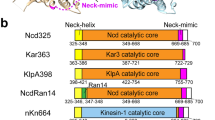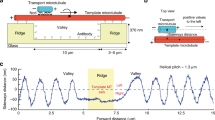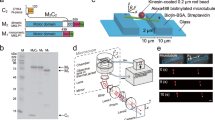Abstract
Kinesin translocation is thought to occur by a conformational change in a region of the motor domain called the neck linker. However, most evidence supporting this hypothesis comes from monomeric constructs unable to move processively. To address this issue, we investigated the neck-linker configuration on microtubule-bound monomeric and dimeric kinesin constructs using single-molecule fluorescence polarization microscopy. We found that the neck-linker region (i) is very mobile in the absence of nucleotides and during steady walking, (ii) decreases mobility and aligns along the microtubule axis in the presence of AMPPNP or ADP+AlF−4, (iii) is mostly ordered in the monomeric constructs in the presence of ADP+AlF−4, and (iv) is closer to parallel to the microtubule axis in the dimeric constructs. These results support the proposed role of the neck linker and suggest a coordination mechanism between the two motor domains in the dimer.
This is a preview of subscription content, access via your institution
Access options
Subscribe to this journal
Receive 12 print issues and online access
$189.00 per year
only $15.75 per issue
Buy this article
- Purchase on Springer Link
- Instant access to full article PDF
Prices may be subject to local taxes which are calculated during checkout





Similar content being viewed by others
References
Goldstein, L.S. & Philp, A.V. The road less traveled: emerging principles of kinesin motor utilization. Annu. Rev. Cell Dev. Biol. 15, 141–183 (1999).
Lawrence, C.J. et al. A standardized kinesin nomenclature. J. Cell Biol. 167, 19–22 (2004).
Schnitzer, M.J. & Block, S.M. Kinesin hydrolyses one ATP per 8-nm step. Nature 388, 386–390 (1997).
Coy, D.L., Wagenbach, M. & Howard, J. Kinesin takes one 8-nm step for each ATP that it hydrolyzes. J. Biol. Chem. 274, 3667–3671 (1999).
Hua, W., Young, E.C., Fleming, M.L. & Gelles, J. Coupling of kinesin steps to ATP hydrolysis. Nature 388, 390–393 (1997).
Asbury, C.L., Fehr, A.N. & Block, S.M. Kinesin moves by an asymmetric hand-over-hand mechanism. Science 302, 2130–2134 (2003).
Kaseda, K., Higuchi, H. & Hirose, K. Alternate fast and slow stepping of a heterodimeric kinesin molecule. Nat. Cell Biol. 5, 1079–1082 (2003).
Yildiz, A., Tomishige, M., Vale, R.D. & Selvin, P.R. Kinesin walks hand-over-hand. Science 303, 676–678 (2004).
Rice, S. et al. A structural change in the kinesin motor protein that drives motility. Nature 402, 778–784 (1999).
Vale, R.D. & Milligan, R.A. The way things move: looking under the hood of molecular motor proteins. Science 288, 88–95 (2000).
Tomishige, M. & Vale, R.D. Controlling kinesin by reversible disulfide cross-linking. Identifying the motility-producing conformational change. J. Cell Biol. 151, 1081–1092 (2000).
Skiniotis, G. et al. Nucleotide-induced conformations in the neck region of dimeric kinesin. EMBO J. 22, 1518–1528 (2003).
Rosenfeld, S.S., Jefferson, G.M. & King, P.H. ATP reorients the neck linker of kinesin in two sequential steps. J. Biol. Chem. 276, 40167–40174 (2001).
Sugata, K., Nakamura, M., Ueki, S., Fajer, P.G. & Arata, T. ESR reveals the mobility of the neck linker in dimeric kinesin. Biochem. Biophys. Res. Commun. 314, 447–451 (2004).
Corrie, J.E. et al. Dynamic measurement of myosin light-chain-domain tilt and twist in muscle contraction. Nature 400, 425–430 (1999).
Peterman, E.J., Sosa, H., Goldstein, L.S. & Moerner, W.E. Polarized fluorescence microscopy of individual and many kinesin motors bound to axonemal microtubules. Biophys. J. 81, 2851–2863 (2001).
Jiang, W., Stock, M.F., Li, X. & Hackney, D.D. Influence of the kinesin neck domain on dimerization and ATPase kinetics. J. Biol. Chem. 272, 7626–7632 (1997).
Asenjo, A.B., Krohn, N. & Sosa, H. Configuration of the two kinesin motor domains during ATP hydrolysis. Nat. Struct. Biol. 10, 836–842 (2003).
Case, R.B., Pierce, D.W., Hom-Booher, N., Hart, C.L. & Vale, R.D. The directional preference of kinesin motors is specified by an element outside of the motor catalytic domain. Cell 90, 959–966 (1997).
Sosa, H., Peterman, E.J., Moerner, W.E. & Goldstein, L.S. ADP-induced rocking of the kinesin motor domain revealed by single-molecule fluorescence polarization microscopy. Nat. Struct. Biol. 8, 540–544 (2001).
Rice, S. et al. Thermodynamic properties of the kinesin neck-region docking to the catalytic core. Biophys. J. 84, 1844–1854 (2003).
Forkey, J.N., Quinlan, M.E., Shaw, M.A., Corrie, J.E. & Goldman, Y.E. Three-dimensional structural dynamics of myosin V by single-molecule fluorescence polarization. Nature 422, 399–404 (2003).
Uemura, S. & Ishiwata, S. Loading direction regulates the affinity of ADP for kinesin. Nat. Struct. Biol. 10, 308–311 (2003).
Rosenfeld, S.S., Fordyce, P.M., Jefferson, G.M., King, P.H. & Block, S.M. Stepping and stretching. How kinesin uses internal strain to walk processively. J. Biol. Chem. 278, 18550–18556 (2003).
Cross, R.A. The kinetic mechanism of kinesin. Trends Biochem. Sci. 29, 301–309 (2004).
Klumpp, L.M., Hoenger, A. & Gilbert, S.P. Kinesin's second step. Proc. Natl. Acad. Sci. USA 101, 3444–3449 (2004).
Hackney, D.D., Stock, M.F., Moore, J. & Patterson, R.A. Modulation of kinesin half-site ADP release and kinetic processivity by a spacer between the head groups. Biochemistry 42, 12011–12018 (2003).
Peterman, E.J., Sosa, H. & Moerner, W.E. Single-molecule fluorescence spectroscopy and microscopy of biomolecular motors. Annu. Rev. Phys. Chem. 55, 79–96 (2004).
Sindelar, C.V. et al. Two conformations in the human kinesin power stroke defined by X-ray crystallography and EPR spectroscopy. Nat. Struct. Biol. 9, 844–848 (2002).
Sosa, H. et al. A model for the microtubule-Ncd motor protein complex obtained by cryo-electron microscopy and image analysis. Cell 90, 217–224 (1997).
Hoenger, A. et al. Image reconstructions of microtubules decorated with monomeric and dimeric kinesins: comparison with x-ray structure and implications for motility. J. Cell Biol. 141, 419–430 (1998).
Kikkawa, M. et al. Switch-based mechanism of kinesin motors. Nature 411, 439–445 (2001).
Romberg, L. & Vale, R.D. Chemomechanical cycle of kinesin differs from that of myosin. Nature 361, 168–170 (1993).
Crevel, I.M., Lockhart, A. & Cross, R.A. Weak and strong states of kinesin and ncd. J. Mol. Biol. 257, 66–76 (1996).
Acknowledgements
We thank D. Buster and D. Sharp for discussions and critical reading of the manuscript, R. Fenton for technical help and H. Deng and E. Nieves for mass spectrometry and analysis. This project was supported by a US National Institutes of Health grant (RO1-AR48620) to H.S.
Author information
Authors and Affiliations
Corresponding author
Ethics declarations
Competing interests
The authors declare no competing financial interests.
Supplementary information
Supplementary Fig. 1
KM330_335 single-molecule frequency distributions (PDF 108 kb)
Supplementary Table 1
Kolmogorov-Smirnov statistical tests (PDF 104 kb)
Rights and permissions
About this article
Cite this article
Asenjo, A., Weinberg, Y. & Sosa, H. Nucleotide binding and hydrolysis induces a disorder-order transition in the kinesin neck-linker region. Nat Struct Mol Biol 13, 648–654 (2006). https://doi.org/10.1038/nsmb1109
Received:
Accepted:
Published:
Issue Date:
DOI: https://doi.org/10.1038/nsmb1109
This article is cited by
-
Solution NMR assignments and structure for the dimeric kinesin neck domain
Biomolecular NMR Assignments (2023)
-
Structural basis of mechano-chemical coupling by the mitotic kinesin KIF14
Nature Communications (2021)
-
Shaft Function of Kinesin-1’s α4 Helix in the Processive Movement
Cellular and Molecular Bioengineering (2019)
-
Anchor Effect of Interactions Between Kinesin’s Nucleotide-Binding Pocket and Microtubule
Cellular and Molecular Bioengineering (2017)
-
Kinesin Motor Enzymology: Chemistry, Structure, and Physics of Nanoscale Molecular Machines
Biophysical Reviews (2015)



